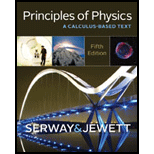
(a)
The expectation value of
(a)
Answer to Problem 57P
The expectation value of
Explanation of Solution
Write the equation for the expectation value of
Here,
Write the expression of the given wave function.
Write the expression for the complex conjugate of the given wave function.
Put equations (II) and (III) in equation (I) and rearrange it.
Integrate the above equation.
Conclusion:
Therefore, the expectation value of
(b)
The probability of finding the particle near
(b)
Answer to Problem 57P
The probability of finding the particle near
Explanation of Solution
Write the equation for the probability that the particle lies in the range
Here,
Put equations (II) and (III) in equation (IV) and rearrange it.
Integrate the above equation.
Conclusion:
Therefore, the probability of finding the particle near
(c)
The probability of finding the particle near
(c)
Answer to Problem 57P
The probability of finding the particle near
Explanation of Solution
Write the equation for the probability that the particle lies in the range
Put equations (II) and (III) in equation (IV) and rearrange it.
Integrate the above equation.
Conclusion:
Therefore, the probability of finding the particle near
(d)
The argument for the statement that the result of part (a) does not contradict the result of part (b) and part (c).
(d)
Answer to Problem 57P
It is more probable to find the particle either near
Explanation of Solution
Probability density is the relative probability per unit volume that the particle will be found at any given point in the volume. The probability density for the given function with
The expectation value of
Conclusion:
Thus, it is more probable to find the particle either near
Want to see more full solutions like this?
Chapter 28 Solutions
Principles of Physics
- Suppose a wave function is discontinuous at some point. Can this function represent a quantum state of some physical particle? Why? Why not?arrow_forwardIf Ψ is the wave function, the probability density function is given by _____________ a) |Ψ| b) |Ψ|2 c) |Ψ|3 d) |Ψ|4arrow_forwardShow that normalizing the particle-in-a-box wave function ψ_n (x)=A sin(nπx/L) gives A=√(2/L).arrow_forward
- A quantum particle is described by the wave function ψ(x) = A cos (2πx/L) for −L/4 ≤ x ≤ L/4 and ψ(x) everywhere else. Determine:arrow_forwardA Quantum system has a ground state with energy E0 = 100meV and a 3-fold degenerate excited state with energy E1 = 100meV . Calculate the probability of finding the system in its groud state when it is at T = 300 K? a) 0.94 b) 0.06 c) 1 d) 0.98arrow_forwardShow that the wave function ψ = Ae i(i-ωt) is a solution to the Schrödinger equation (as shown), where k = 2π/λ and U = 0.arrow_forward
 Principles of Physics: A Calculus-Based TextPhysicsISBN:9781133104261Author:Raymond A. Serway, John W. JewettPublisher:Cengage Learning
Principles of Physics: A Calculus-Based TextPhysicsISBN:9781133104261Author:Raymond A. Serway, John W. JewettPublisher:Cengage Learning Physics for Scientists and Engineers with Modern ...PhysicsISBN:9781337553292Author:Raymond A. Serway, John W. JewettPublisher:Cengage Learning
Physics for Scientists and Engineers with Modern ...PhysicsISBN:9781337553292Author:Raymond A. Serway, John W. JewettPublisher:Cengage Learning University Physics Volume 3PhysicsISBN:9781938168185Author:William Moebs, Jeff SannyPublisher:OpenStax
University Physics Volume 3PhysicsISBN:9781938168185Author:William Moebs, Jeff SannyPublisher:OpenStax


